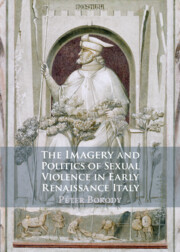Book contents
- The Imagery and Politics of Sexual Violence in Early Renaissance Italy
- The Imagery and Politics of Sexual Violence in Early Renaissance Italy
- Copyright page
- Contents
- Acknowledgments
- One Introduction
- Two Victims of Lust
- Three Medicalized Misogyny
- Four Rape As a Weapon of War
- Five Political Allegories
- Six Abduction in Illustrated Romances
- Seven Lucretia and the Renaissance of Rape
- Eight Conclusion
- Bibliography
- Index
Seven - Lucretia and the Renaissance of Rape
Published online by Cambridge University Press: 13 January 2023
- The Imagery and Politics of Sexual Violence in Early Renaissance Italy
- The Imagery and Politics of Sexual Violence in Early Renaissance Italy
- Copyright page
- Contents
- Acknowledgments
- One Introduction
- Two Victims of Lust
- Three Medicalized Misogyny
- Four Rape As a Weapon of War
- Five Political Allegories
- Six Abduction in Illustrated Romances
- Seven Lucretia and the Renaissance of Rape
- Eight Conclusion
- Bibliography
- Index
Summary
Presumably not long after his arrival in Rome, Raphael drew a figure of Lucretia (Figure 7.1).1 The drawing is a telling example of the transformation of her reception. After 1500, the Roman heroine of freedom and chastity became a pin-up model.2 Raphael skillfully anticipates the requirements of the genre. Her torn attire follows the curves of her body, and a dysfunctional fold underscores her genitalia. Her hair is tied but slightly disheveled. The theatrical gesture of the left arm conveniently reveals her bare breast. The dagger in her right-hand changes into an overt phallic reference from a mortal instrument. Lucretia has just been raped and her suicide is imminent, yet the painter opts for a voyeuristic presentation of her body. The narrative context and physical signs of violence are retained inasmuch as they support this sanitized scenario.
- Type
- Chapter
- Information
- Publisher: Cambridge University PressPrint publication year: 2023
- 1
- Cited by

